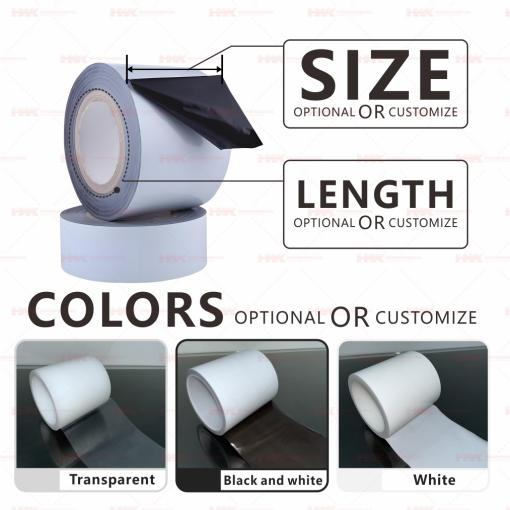Wat Bepaal die Duursaamheid van Polietileen (PE) Beskermende Folie in Industriële Gebruik
Die beskermingsfilme wat van polietileen (PE) gemaak word, speel 'n belangrike rol in die vervaardigings-, vervoer- en installasiebedrywe deur oppervlakbeskerming te bied. Die faktore wat die lewensduur van sulke filme kan beïnvloed moet bekend wees sodat hulle hul optimale funksie kan vervul. Die tweede aspek van hierdie artikel is om 'n begrip van die faktore wat die lewensduur van PE-beskermingsfilme beïnvloed, te verskaf, met 'n spesifieke fokus op die invloed van digtheid en oppervlakbehandeling.
LDPE teen HDPE Films: Invloed van Digtheid op Skeurweerstand
Polietileen is so uiteenlopend, maar Lae-Digtheid Polietileen (LDPE) en Hoë-Digtheid Polietileen (HDPE) word die meeste in beskermingsfilme gebruik. Die groot verskil in digtheid tussen LDPE en HDPE is die hoofverskil tussen die twee, en dit beïnvloed hul skeurweerstand aansienlik en gevolglik hul lewensduur in industriële toepassings.
L LDPE word gekenmerk deur sy buigsaamheid en laer digtheid wat dit rekbaar maak. Die voordeel van hierdie eienskap kom tot uiting waar die films onreëlmatige oppervlakke moet volg of akkuraat om voorwerpe moet wikkelen. Maar die laer digtheid beteken ook dat LDPE-films nie so skeurweerstandig is as HDPE nie. LDPE mag nie die beste opsie wees in situasies waar punctuur- en skeurweerstand baie belangrik is nie, byvoorbeeld in konstruktiewe toepassings of swaarweg verpakking.
In vergelyking daarmee het HDPE 'n hoër digtheid wat dit sterker en stywer in filmvorm maak. Hierdie verhoogde digtheid gee HDPE-films ook 'n beter skeurweerstand, en daarom is dit die gewenste materiaal in ander eisende industriële toepassings waar duursaamheid 'n kwessie is. As voorbeeld, in gevalle waar die films aan skerp rande blootgestel word en/of gereeld hanteer moet word, het HDPE 'n meer robuuste struktuur en bied dit beter beskerming.
Hoe Oppervlak Behandeling Verbeter Aanhegting in PE Film Toepassings
Die ander groot bepalende faktor rakende die lewensduur van PE-beskermende folies is die oppervlakbehandeling tydens produksie. Die oppervlakbehandeling-tegnologieë het ten doel om die kleefeienskappe van PE-folie te verbeter, sodat dit aan oppervlakke kan heg en geen kleefrue oorlaat wanneer dit verwyder word nie, ongeag die omstandighede.
Een van die tipiese maniere om die hegting te verbeter, is deur koronabehandeling toe te pas wanneer die PE-folie aan 'n hoëspanning-gesketterde elektriese ontlading blootgestel word. 'n Sodanige proses veroorsaak dat die folie 'n beter hegsel op 'n wye verskeidenheid substate vorm, aangesien die oppervlakenergie van die film verhoog word. 'n Verhoogde hegsel is ook nodig in die industrie om die optel of afbladder van die film te elimineer indien dit hanteer word, of as gevolg van omgewingsveranderings.
Minder belangrik is die vlambehandeling, 'n prosedure wat ook die eienskappe van die film op sy oppervlak probeer verander. Die effek van die kortstondige blootstelling van die film aan 'n vlam is om die molekulêre struktuur van die oppervlak te verander, wat lei tot beter bevochtigbaarheid en kleefeienskappe. Sulke behandelings verbeter kleefkrag, maar lei ook tot 'n film wat 'n sekere mate van weerstand teen omgewingsveranderlikes, insluitend temperatuurveranderinge en humiditeit, bied.
Daarbenewens is die keuse van kleefstof wat in kombinasie met oppervlakbehandeling toegepas word, van belang. 'n Geskikte kleefstof wat gebruik word om die oppervlak te behandel, sal die lewensduur van die film aansienlik kan verleng. As voorbeeld, die gebruik van drukgevoelige kleefstowwe reageer op die toegepaste krag en kan dit ontwerp word om by 'n sekere industriële toepassing te pas waar die PE-film as beskermende film dien sonder om die eienskap van die onderliggende oppervlak te verzwak.
Gevolgtrekking
Die kombineervermoë van die eienskappe van materiale sowel as die metode van behandeling; is wat bepaal watter polietileen beskermende folies regtig lank hou in industriële gebruik. Wanneer daar gekies word tussen LDPE en HDPE, is die toepassingsvereiste die bepalende faktor om buigsaamheid/ aanpasbaarheid te balanseer teen krag en skeurweerstand. Intussen is oppervlakbehandelingsmetodes ook belangrik, aangesien dit deur hulle is dat hegsaamheid vermy word deur ingrepe.
Laastens kan die keuse van die toepaslike tipe polietileenfolie en die verbetering van die oppervlakeienskappe van die folie met behulp van gesofistikeerde behandelings lei tot 'n beter beskermende oplossing met 'n langer lewensduur. In nywe wat sterk op hierdie folies staatmaak om sensitiewe oppervlakke te beskerm, is kennis van hierdie bepalende faktore noodsaaklik vir die optimale gebruik en om seker te maak dat sulke folies doeltreffend gebruik word vir hul spesifieke beskermingsdoeleindes, soos verwagte lewensduur.
 EN
EN
 AR
AR
 CS
CS
 DA
DA
 NL
NL
 FI
FI
 FR
FR
 DE
DE
 EL
EL
 HI
HI
 IT
IT
 JA
JA
 KO
KO
 PL
PL
 PT
PT
 RO
RO
 RU
RU
 ES
ES
 TL
TL
 IW
IW
 ID
ID
 SR
SR
 UK
UK
 VI
VI
 HU
HU
 TH
TH
 TR
TR
 FA
FA
 AF
AF
 MS
MS
 GA
GA
 BE
BE
 IS
IS
 HY
HY
 BN
BN
 LA
LA
 MN
MN
 SO
SO
 MY
MY
 KK
KK

